Chapter 11 Habits And Habitats Of Some Important Animals
Behavioural Science And Behavioural Scientists
Introduction
Behavioural science is the systematic analysis and investigation of human and animal behaviour through controlled and naturalistic observation and disciplined scientific experimentation.
Examples of behavioural sciences include psychology, psychobiology, criminology and cognitive science. The investigative study related to this field aims to.
- Describe the behaviour
- Predict behaviour
- Determine the causes behind the behaviour Netherlands and Konrad Lorenz of Austria. and,
- Understand or explain behaviour.
Behavioural Biology is an interdisciplinary field of science that examines the bidirectional interactions between behaviour and biology.
Read And Learn More: WBBSE Notes For Class 6 School Science
The study of animal behaviour is known as Ethology.
Although many naturalists have studied aspects of animal behaviour through the centuries, the modern science of ethology is usually considered to have arisen as a discrete discipline with the work (in the 1920s) of biologists Nikolaas Tinbergen of the Netherlands and Korenz Lorenz of Austria.
Chapter 11 Habits And Habitats Of Some Important Animals History of Behavioural Science
Ethology has existed as a concept since 1762 when it was defined in France as the study of animal behaviour.
In this sense, it carries the same meaning as the Greek word “ethos”, from which the modern term ethology is derived.
Many naturalists have studied aspects of animal behaviour throughout history.
Ethology has its scientific roots in the work of Charles Darwin and of American and German ornithologists of the late 19th and early 20th century, including Charles O.
Whitman, Oskar Heinroth and Wallace Craig.
The modern discipline of ethology is generally considered to have begun during the 1930s with the work of Dutch biologist Nikolaas Tinbergen and Austrian biologists Konrad Lorenz and Karl von Frisch, joint awardees of the 1973 Nobel Prize in Physiology or Medicine.
Ethology is a combination of laboratory and field science with a strong relation to some other disciplines such as neuroanatomy, ecology, and evolutionary biology.
Ethologists are typically interested in a behavioural process rather than in a particular animal group, and often study one type of behaviour, such as aggression, in a number of unrelated animals.
Ethology is a rapidly growing field. Since the dawn of the 21st century, many aspects of animal communication, emotions, culture, learning and sexuality that the scientific community long thought it understood have been re-examined, and new conclusions reached.
New fields, such as neuroethology, have developed. Understanding ethology or animal behaviour can be important in animal training.
Considering the natural behaviours of different species or breeds enables the trainer to select the individuals best suited to perform the required task.
It also enables the trainer to encourage the performance of naturally occurring behaviours and also the discontinuance of undesirable behaviours.
The founder of modern ethology is Konrad Z. Lorenz, a physician, zoologist, and comparative anatomist. By systematic application of biological research methods to the analysis of animal behaviour, he provided the initial.
impetus in the 1930s. The first modern ethology textbook, The Study of Instinct, was written by Nikolaas Tinbergen in 1951. E. H. Hess (1962) and Eibl-Eibesfeldt (1966) produced summaries of the modern concepts of behaviour.
The observations of a number of pioneers, including Spalding (1873), Darwin (1872), Whitman (1898), Altum (1868), Heinroth (1911), and Craig (1918), awakened scientific interest in animal behaviour, and ethology came to be considered an independent branch of zoology around 1910.
Chapter 11 Habits And Habitats Of Some Important Animals Some Notable Behavioural Scientists
1. Charles Robert Darwin:
Naturalist Charles Darwin was born in Shrewsbury, England, on February 12, 1809. In 1831, he embarked on a five-year survey voyage around the world on the HMS Beagle.
His studies of specimens around the globe led him to formulate his theory of evolution and his views on the process of natural selection.
On November 24, 1859, he published a detailed explanation of his theory in his best-known work, On the Origin of Species by Means of Natural Selection. He died on April 19, 1882, in London.
Darwin proposed that instincts were behavioural adaptations that had evolved by natural selection.
Darwin provided many examples of instinctive behaviours in animals and suggested how such behaviours could have evolved.
He explained the roles that emotions play in the biology of animals and extended those explanations to humans.

2. Jean Henri Fabre:
Jean Henri Fabre (December 22, 1823- October 11, 1915) was a French entomologist, famous for his study of the anatomy and behaviour of insects.
Largely self-taught, Fabre began his career as a Physics teacher at Carpentras (France). From his youth, he was attracted by the beauty of butterflies and grasshoppers.
Fabre did important research on the insect of bees, wasps, beetles, grasshoppers and crickets.
Based on his observations of the paralyzing actions of wasps in response to stimulating zones in their prey, he described the importance of inherited instinct as a behaviour pattern in insects.
Although Fabre never accepted the theory of evolution, his work was respected by Darwin.

3. Nikolaas Tinbergen:
Niko Tinbergen (April 15, 1907- December 21, 1988) was a Dutch ethologist, zoologist, and ornithologist.
He shared the 1973 Nobel Prize in Physiology or Medicine with Karl von Frisch and Konrad Lorenz for their discoveries concerning the organization and elicitation of individual and social behaviour patterns in animals.
Together with Lorenz, Tinbergen established European ethology as the study of the behavioural patterns of animals in the context of their natural environments.
Tinbergen believed that the study of ethology should be applied to human behaviour as well as animals.
This did not mean that animal behaviour should be extrapolated to humans but that the same methodology could be applied.
Tinbergen emphasized the importance of both instinctive and learned behaviour to survival and used animal behaviour as a basis for speculations about the nature of human violence and aggression.
He is especially well known for his long-term observation of seagulls, which led to important generalizations on courtship and mating behaviour.

4. Konrad Lorenz:
Konrad Lorenz (November 7, 1903-February 27, 1989) was an Austrian zoologist, founder of modern ethology, and famous for the study of animal behaviour by means of comparative zoological methods.
His ideas contributed to an understanding of how behavioural patterns may be traced to an evolutionary past, and he was also known for his work on the roots of aggression.
He shared the Nobel Prize for Physiology or Medicine in 1973 with the animal behaviourists Karl Von Frisch and Nikolaas Tinbergen.
Encouraged by the positive response to his scientific work, Lorenz established colonies of birds, such as the jackdaw and greylag goose, published a series of research papers on his observations and soon gained an international reputation.

5. Karl von Frisch:
Karl von Frisch (November 20, 1886-June 12, 1982) was a zoologist, whose studies on communication among bees added significantly to the knowledge of the chemical and visual sensors of insects.
He shared the Nobel Prize in 1973 for Physiology or Medicine jointly with animal behaviourists Konrad Lorenz and Nikolaas Tinbergen.
In 1949 Frisch established that bees, through their perception of polarized light, use the Sun as a compass.
He also found that they are capable of using this method of orientation when the Sun is not visible, apparently remembering patterns of polarization presented by the sky at different times of the day and the location of previously encountered landmarks.

6. Valerie Jane Goodall:
Born on April 3, 1934, in London, England, Jane Goodall set out to Tanzania to study chimpanzees by sitting amongst them, bypassing more high procedures and uncovering discoveries about primate behaviour that have continued to shape scientific discourse.
She is a highly respected member of the world scientific community. By remaining in almost constant contact with the chimps, she discovered a number of previously unobserved behaviours.
She noted that chimps have a complex social system, complete with ritualized behaviours and primitive but discernible communication methods, including a primitive “language” system containing more than 20 individual sounds.
She is credited with making the first recorded observations of chimpanzees eating meat and using and making tools.
Tool making was previously thought to be an exclusively human trait, used, until her discovery, to distinguish humans from animals.
She also noted that chimpanzees throw stones as weapons, use touch and embraces to comfort one another and develop long-term familial bonds.

7. Salim Ali:
Salim Moizuddin Abdul Ali (12 November, 1896-20 June, 1987) was an Indian ornithologist and naturalist.
Sometimes referred to as the “birdman of India”, Salim Ali was among the first Indians to conduct systematic bird surveys across India and several bird books that he wrote helped popularize ornithology in India.
He became the key figure behind the Bombay Natural History Society after 1947 and used his personal influence to garner government support for the organisation, create the Bharatpur bird sanctuary (Keoladeo National Park) and we do prevent the destruction of what is now the Silent Valley National Park.
Along with Sidney Dillon Ripley, he wrote the ten-volume Handbook of the Bird of India and Pakistan, a second edition of which was completed after his death.
He was awarded the Padma Bhushan in 1958 and the Padma Vibhushan in 1976.

8. Raghavendra Gadagkar:
Raghavendra Gadagkar was born in 1953 in Kanpur. Gadagkar is a professor at the Centre for Ecological Sciences.
Indian Institute of Science in Bangalore, India, studies the evolution of social behaviour using locally common wasps as a model.
His first book, Survival Strategies, has been translated into Chinese and Korean languages.
It uses simple language to explain recent advances in behavioural ecology and sociobiology to a general audience.
He has won numerous awards for his contributions to scientific research and the Shanti Swarup Bhatnagar Award in Biology in 1993.

9. M. K. Chandrashekaran:
Maroli Krishnayya Chandrashekaran (4 September 1937-2 July 2009) was an Indian zoologist, regarded as the founder of Indian chronobiology, the study of biological rhythms of organisms.
He studied the light- sensitivity of the eyes of bats associated with dawn and dusk as well as colours and flashes.

10. Ratan Lal Brahmachary:
Veteran wildlife biologist R.L. Brahmachary is a pioneer in tiger pheromone research.
He is known for his work in many fields like agricultural sciences, zoology, botany, and biometrics, did much of his work at Indian Statistical.

11. Gopal Chandra Bhattacharya:
Gopal Chandra Bhattacharya (1 August 1895-8 April 1981) was an Indian entomologist and naturalist.
One of his monumental works was the book “Banglar Kitpatanga” (The Insects of Bengal) which fetched him the Rabindra Purashkar in 1975. He had already been awarded the Ananda Purashkar in 1968.
Gopal did not have formal education beyond school and this was the cause of much humiliation for him
when well-established scientists refused to acknowledge his work.
He published his first research papers in 1932, on life events in the body of plants.
Subsequently, he also published work on bioluminescence and other botany topics, but gradually his interests shifted to entomology.
He became an expert photographer and photographed many varieties of ants, spiders, small bats and tadpoles.
Credited with popularizing science in Bengal, he is best known for his studies in insects and metamorphosis.
He was awarded the Rabindra Puraskar, Bengal’s highest literary award, in 1975. He worked as a school teacher and published a handwritten literary magazine.
Published his first article on bioluminescence in the then-popular Bengali periodical ‘Prabasi”.
This attracted the attention of none other than Dr. Jagadish Chandra Bose who, realizing his potential, organized a position for him at the Basu Vigyan Mandir (now christened the Bose Institute) where he was employed basically as a technical assistant.

The Habits and Behaviour of Some Animals
Introduction
In zoology (particularly in ethology) habit usually refers to the behaviour of animals.
The study of animal behaviour begins with understanding how an animal’s physiology and anatomy are integrated with its behaviour.
Both external and internal stimuli prompt behaviours-external information (for example threats from other animals, sounds, smells) or weather and internal information (for example hunger, fear).
Understanding how genes and the environment come together to shape animal behaviour is also an important underpinning of the field.
Genes capture the evolutionary responses of prior populations to selection on behaviour. Environment flexibility gives animals the opportunity to adjust the changes during their own lifetime.
Scientists are drawn to the study of animal behaviour for varied reasons and the field is extremely broad, ranging from research on feeding behaviour and habitat selection to mating behaviour and social organizations.
Many scientists study animal behaviour because it sheds light on human beings.
Research on non-human primates, for instance, continues to offer perspectives into the causes and evolution of individual, social, and reproductive human actions.
Understanding why some animals help others at the potential cost of their own survival and reproduction, for example, not only gives us insight into their behaviour but could also potentially help us to understand the underpinnings of our species’ ideas of altruism and sacrifice.
Other scientists are motivated by environmental concerns.
When we gain insight into animal behaviour, we are in a stronger position to understand vexing conservation problems, such as how to save endangered species, assess environmental quality, design nature preserves, and evaluate the importance of human-related threats to survival in otherwise fit animals.
To develop a rich understanding of animal behaviour, let us now discuss a few animals and their interesting behaviours.
Chapter 11 Habits And Habitats Of Some Important Animals Ants
Ants are truly social or eusocial insects. Ants evolved from wasp-like ancestors between 110 and 130 million years ago and diversified after the rise of flowering plants.
More than 12,500 of an estimated total of 22,000 species have been classified.
They are easily identified by their elbowed antennae and the distinct node-like structure that forms their slender waists.
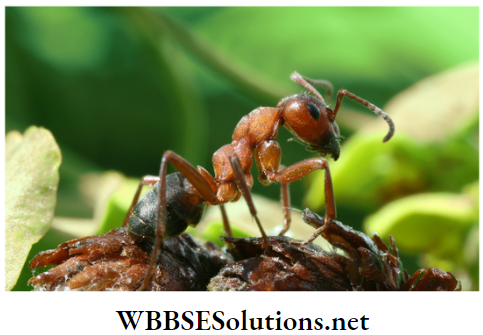
Ants form colonies that range in size from a few dozen predatory individuals living in small natural cavities to highly organised colonies that may occupy large territories and consist of millions of individuals.
Larger colonies consist mostly of sterile, wingless females forming castes of “workers”, “soldiers”, or other specialised groups.
Nearly all ant colonies also have some fertile males called “drones” and one or more fertile females called “queens”.
The colonies are described as superorganisms because the ants appear to operate as a unified entity, collectively working together to support the colony.
Ants communicate with each other. through tapping with the antennae and smell. The queen emits a scent that makes all the workers behave in the way they do.
An ant that loses its way to the nest does not live long. So, if you take ants away from their nest, or trail, they are likely to die in great need of their nest’s smell (and probably quite hungry).
Ants have colonised almost every landmass on Earth. The only places lacking indigenous ants are Antarctica and a few remote or inhospitable islands.
Ant societies have a division of labour, communication between individuals, and an ability to solve complex problems.
These parallels with human societies have long been an inspiration and subject of study. Many human cultures make use of ants in cuisine, medication, and rituals.
Their ability to exploit resources may bring ants into conflict with humans, however, as they can damage crops and invade buildings.
Some species, such as the red fire ants are regarded as invasive species. Some ants have ‘armies’ and are very organized in causing.
Chapter 11 Habits And Habitats Of Some Important Animals Termites
Termites are eusocial insects that are closely related to cockroaches. Although these insects are often called white ants, they are not ants.
Termites are usually small, measuring between 4 to 15 millimetres (0.16 to 0.59 inches) in length, but larger species are also found.
Most worker and soldier termites are completely blind and do not have a pair of eyes.
Termite antennae have a number of functions such as sensing touch, taste, odours (including pheromones), heat and vibration.
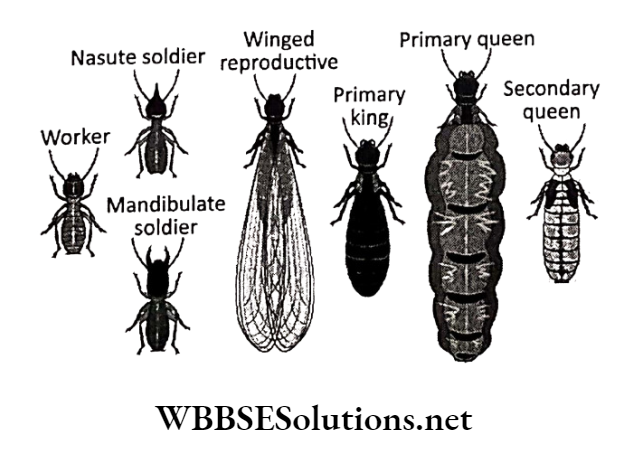
Apart from male and female ants, other kinds of ants that are found include:
1. Red ants:
Red ants are aggressive, good at fighting and can cause painful bites because of their sharp teeth. They mostly live in the tir bark of trees.
2. Black ants:
Black ants are fairly docile, hard workers and are more intelligent compared to red ants.
3. Nomadic ants:
These are found in hot countries. They keep changing their nests. from time to time.
4. Peasant ants:
Peasant ants make a hole in the ground and build nests therein. The leaves which fall in their nests get rotten and a whitish fungus forms on top of them. This fungus is a favourite food for the peasant ants.

Termites divide labour among castes consisting of sterile male and female “workers” and “soldiers”. All colonies have fertile males called “kings” and one or more fertile females called “queens”.
The queen of the colony is responsible for egg production. Unlike in ants the king mates with her for life.
Termites mostly feed on dead plant material and cellulose, generally in the form of wood, leaf litter, soil, or animal dung.
They also play a vital role in the ecosystem by recycling waste material such as dead wood, faeces and plants.
Worker termites undertake the most labour within the colony, being responsible for foraging, food storage, and brood and nest maintenance.
Workers are tasked with the digestion of cellulose in food and are thus the most likely caste to be found in infested wood. The process of worker termites feeding other nestmates is known as trophallaxis.
Trophallaxis is an effective nutritional tactic to convert and recycle nitrogenous components.
The soldier caste has anatomical and behavioural specialisations, and their sole purpose is to defend the colony.
Many soldiers have large heads with highly modified powerful jaws so enlarged they cannot feed themselves.
Instead, like juveniles, they are fed by workers. Termites do not usually come out of their holes because if they are too exposed to sunlight, the water in their bodies dries up.
Chemical substances such as pheromones and hormones play a role in the differentiation, production, and regulation of castes.
Both reproductive and soldier castes secrete a pheromone (chemical signal) that is transmitted through food sharing (trophallaxis) and grooming to other members of the colony and inhibits the development of reproductives or soldiers.
Termites are important in two ways. They are destructive when they feed upon, and often destroy wooden structures or vegetable matter valuable to humans.
Termites are also extremely beneficial in that they help to convert plant cellulose into substances that can be recycled into the ecosystem to support growth.
Termites are a delicacy in the diet of some human cultures and are used in many traditional medicines.
Chapter 11 Habits And Habitats Of Some Important Animals Honeybees bes
Honey bees are flying insects and close relatives of wasps and ants. There are five well-recognised types of bees found in the world-
- Apis dorsata (Rock bee)
- Apis florea (Little bee)
- Apis indica (Indian bee)
- Apis mellifera (European bee)
- Apis Adamson (African bee)
Out of these five types, three are common in India. They are Apis dorsata, Apis florea and Apis indica. Honeybees are not native to the United States.
They were brought there from Europe in the 1600s. Bees are an animal most of us learn about very early on, one way or another.
Honey bees are usually very gentle creatures who mind their own business. They are too busy to worry about people or other animals.
Honey bees are normally about 3/ 4 of an inch long. Most bees are workers, which are female, but some are male, called “drones.”
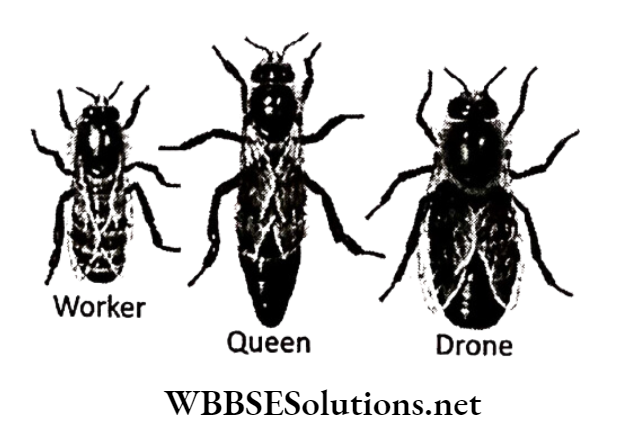
Workers are slightly smaller than drones. All honey bees are reddish brown and black, with orangish-yellow rings on the abdomen (back part of the body).
The head, antennae, and legs are black. Honey bees have thick, pale hair on the thorax (middle part of the body).
Honey bees live in a nest, called a “hive”. A single hive can have up to 80,000 bees, mostly workers. It is usually located in a hollow tree. The hive is ruled over by a queen bee.
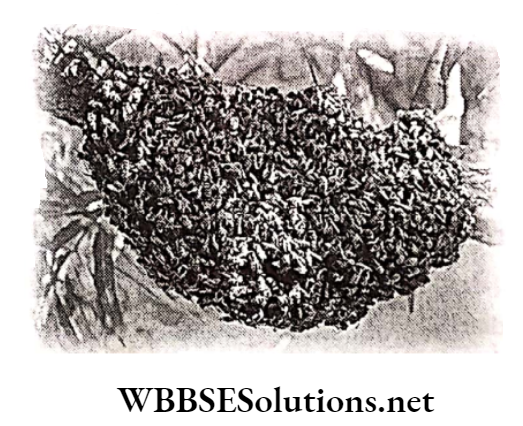
She is the largest bee in the hive, and she is the only female to mate. Males usually just hang around; their only purpose is to mate with the queen.
Then they die. The workers do all of the work inside and outside of the hive.
Their jobs include caring for larvae (baby bees), making wax, building honeycombs, cleaning up the hive, storing pollen, making honey, guarding the hive, and collecting pollen and nectar.
A honeycomb is a layer of wax cells (little rooms) made into a hexagonal (six-sided) shape. The queen will lay eggs in the cells and honey bee babies, called larvae, will hatch.
Larvae will eventually pupate (make a cocoon in their cells), and hatch out as adult bees. Honey bees eat nectar and pollen from flowers.
Nectar is the liquid in a flower, and pollen is a powdery substance which must be transferred from one flower to another to make more flowers.
Larvae eat honey. Queen bees eat royal jelly. Royal jelly is a paste made by worker bees.
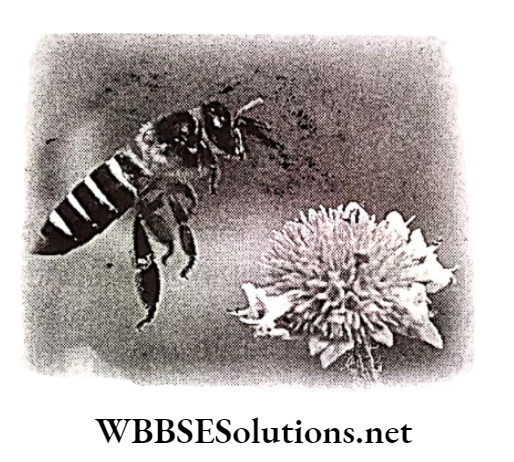
The queen lays eggs which become males, workers, or new queens, depending on the time of year, age of the hive and food provided during larval development.
However, males are always produced from unfertilized eggs by a process known as parthenogenesis.
The new queen will either kill the old queen and be the queen of the old hive or fly away with some other members to establish a new hive.
When honey bees seek out nectar and pollen to make honey with, they visit many different types of flowers and help in pollination.
Once at the flower, the worker bee drinks as much nectar as she can hold. When she gets back to the hive, she passes the nectar on to another worker.
This worker holds the nectar on her tongue until the water evaporates. She is left with honey on her tongue, which is stored in the hive.
Bees eat their store of honey in the winter when there is no food. Karl von Frisch discovered the language used by bees to communicate.
When a bee finds a good place with lots of flowers, she marks the spot with a scent. She then goes back to the hive and does a little “dance” which tells the other bees, the distance and direction to go.
This communication helps the hive locate good places so they don’t waste time always looking for flowers.
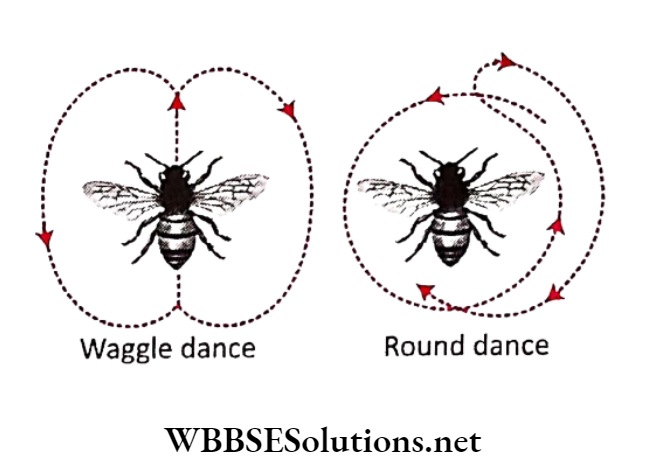
Honey bees are attracted to flowers with bright colours, but they cannot see red. When a bee enters a flower, it has to go deep down to get to the nectar.
While it drinks nectar, the bee gets covered with pollen. The bee also collects the pollen in its pollen basket (part of its hind legs).
When the bee moves on to another flower, some of the pollen from the first flower rubs off on the second flower.
This is pollination. Now the plant will drop its flower and make a fruit with seeds in it. The seeds may grow into a new plant.
The bees cannot live without the plants and the plants cannot live without the bees.
Worker bees have a stinger which is sharp and has a barb on it (like a fishhook). The stinger is attached to a venom gland in the abdomen.
Honey bees only sting if they, or the hive, are in danger.
However, if she stings an animal with tougher tissue, such as a frog or a human, the barb gets caught and the stinger tears out the abdomen, along with the poison gland.
This will kill the honey bee. The venom is what makes the beesting hurt. Beestings, are not really dangerous unless you are allergic to bees.
Honeybees are very important animals. Humans rely on them to pollinate crops, especially fruit trees such as oranges and peaches.
If honey bees don’t transfer pollen from flower to flower, we would have a difficult time growing fruit. People also eat honey and use wax from honeycomb to make candles and other products.
Honey bee venom is used to make medicine to cure arthritis.
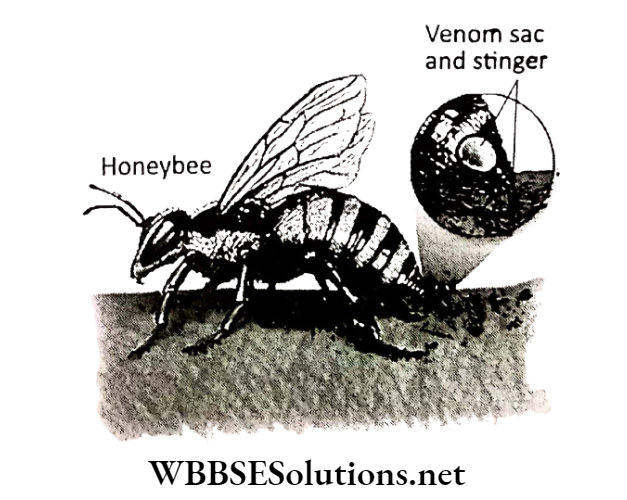
Chapter 11 Habits And Habitats Of Some Important Animals Elephants
Elephants are large mammals. Two species are traditionally recognised, the African elephant (Loxodonta africana) and the Asian elephant (Elephas maximus).
Male African elephants are the largest extant terrestrial animals and can reach a height of 4 m (13 ft) and weigh 7,000 kg.
All elephants have several distinctive features, the most notable of which is a long trunk or proboscis, used for many purposes, particularly breathing, lifting water and grasping objects.
Their incisors grow into tusks, which can serve as weapons and as tools for moving objects and digging. Elephants’ large ear flaps help to control their body temperature.
Their pillar-like legs can carry their great weight. African elephants have larger ears and concave backs while Asian elephants have smaller ears and convex or level backs.
As they are huge in size, elephants eat a lot. Each elephant can eat up to one hundred and fifty kg of grass-branches leaves in a day.
Elephants are herbivorous and can be found in different habitats including savannahs, forests, deserts and marshes. They prefer to stay near water.
They are considered to be keystone species due to their impact on their environments.
Other animals tend to keep their distance whereas predators such as lions, tigers, hyenas, and wild dogs usually target only young elephants.
Females tend to live in family groups, which consist of one female with her calves or several related females with offspring.
The groups are led by an individual known as the matriarch, often the oldest female. Males leave their family groups when they reach puberty (between the ages of 12-15), and may live alone or with other males.
Adult males mostly interact with family groups when looking for a mate and enter a state of aggression known as musth, which helps them gain dominance and reproductive success.
Calves are the centre of attention in their family groups and rely on their mothers for as long as three years. The rules in an elephant society are rather strict.
If an elephant calf gets lost while walking in the forest, the herd tries to search it out. But if they see that the lost calf has found a human shelter, they never accept it back.
Elephants can live up to 70 years in the wild. They communicate by touch, sight, smell and sound; elephants use infrasound, and seismic communication over long distances.
Elephant intelligence has been compared with that of primates and cetaceans. They appear to have self-awareness and show empathy for dying or dead individuals of their kind.
Elephants are not territorial. The home range is between 10-70 km and possibly larger, depending on herd size and seasonality.
Elephants sleep about approximately four hours a night. Elephants are crepuscular in nature, primarily active at dawn and dusk (twilight hours) when the environment is cooler.

Chapter 11 Habits And Habitats Of Some Important Animals Chimpanzees
Chimpanzees (sometimes called chimps) are one of two exclusively African species of great ape that are currently extant. Native to Sub- Saharan Africa, both are currently found in the Congo jungle.
Classified in the genus Pan, they were once considered to be one species.
However, since 1928, they have been recognized as two distinct species the common chimpanzee (Pan troglodytes) live in the north of the Congo River and the bonobo (Pan paniscus) which live in the south.
The most obvious differences are that chimpanzees are somewhat larger, more aggressive and male-dominated, while the bonobos are more gracile, peaceful, and female-dominated.
Their hair is typically black or brown. Males and females differ in size and appearance. Standing approximately 4 feet high, males weigh about 45-55 kg, while females weigh between 30-50 kg.
Both chimps and bonobos are some of the most social great apes, with social bonds occurring among individuals in large communities.
Fruit is the most important component of a chimpanzee’s diet; however, they will also eat vegetation, bark, honey, insects and even other chimps or monkeys.
Chimpanzees rarely live past the age of 50 in the wild but have been known to reach the age of 60 in captivity. Chimpanzees and bonobos are equally the closest living relatives.
As such, they are among the largest-brained, and most intelligent of primates; they use a variety of sophisticated tools and construct elaborate sleeping nests each night from branches and foliage.
They have both been extensively studied for their learning abilities.
There may even be distinctive cultures within populations. Field studies of common chimpanzees were pioneered by primatologist Jane Goodall.
Both Pan species are considered to be endangered as human activities have caused severe declines in the populations and ranges of both species.
Several conservation and rehabilitation organisations are dedicated to the survival of Pan species in the wild.
Anatomical differences between the common chimpanzee and the bonobo are slight, but sexual and social behaviours are markedly different.
The common chimpanzee has an omnivorous diet. Chimps occasionally hunt and eat meat. The bonobo, on the other hand, has a mostly frugivorous diet and non-violent, matriarchal behaviour.
Different groups of chimpanzees also have different cultural behaviour with preferences for types of tools.
The common chimpanzee tends to display greater aggression than the bonobo. The average, captive chimpanzee sleeps 9.7 hours a day.
Studies have shown chimpanzees engage in apparently altruistic behaviour within groups. Chimpanzees live in large multi-male and multi-female social groups, which are called communities.
Within a community, the position of an individual and the influence the individual has on others dictates a definite social hierarchy.
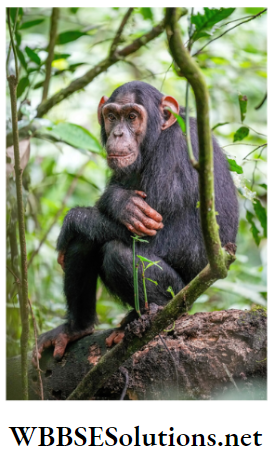
Chimpanzees live in a leaner hierarchy wherein more than one individual may be dominant enough to dominate other members of lower rank.
Typically, a dominant male is referred to as the alpha male. The alpha male is the highest-ranking male that controls the group and maintains order during disputes.
In chimpanzee society, the ‘dominant male’ sometimes is not the largest or strongest male but rather the most manipulative and political male that can influence the goings on within a group.
Male chimpanzees typically attain dominance by cultivating allies who will support that individual during future ambitions for power.
Lower-ranking chimpanzees will show respect by submissively gesturing in body language or reaching out their hands while grunting.
Female chimpanzees will show deference to the alpha male by presenting their hindquarters.
Chimps live in communities. These communities are composed of family groups of three to six individuals, totalling about 50 animals.
Most mothers give birth to one young an average of every five to six years in the wild. Young chimps stay with their mothers for up to 10 years.

Chimpanzees make tools and use them to acquire food and for social displays; they have sophisticated hunting strategies requiring cooperation, influence and rank; they are status.
Conscious, manipulative and capable of deception; they can learn to use symbols and understand aspects of human language including some relational syntax, concepts of numbers and numerical sequence and they are capable of spontaneous planning for a future state or event.
Recent research indicates that chimpanzees’ use of stone tools dates back at least 4,300 years (about 2,300 BC).
One example of chimpanzee tool usage behaviour includes the use of a large stick as a tool to dig into termite mounds and the subsequent use of a small stick altered into a tool that is used to “fish” the termites out of the mound.
Chimpanzees are also known to use smaller stones as hammers and a large one as an anvil in order to break open nuts.
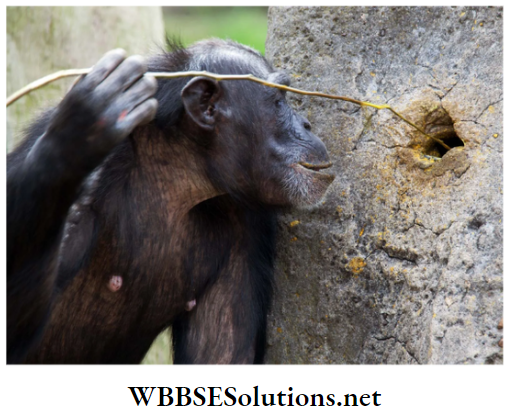
Chapter 11 Habits And Habitats Of Some Important Animals Migratory birds
Avian migration is a natural miracle. Migratory birds fly hundreds and thousands of kilometres to find the best ecological conditions and habitats for feeding, breeding and raising their young.
When conditions at breeding sites become unfavourable, it is time to fly to regions where conditions are better.
Birds migrate to move from areas of low or decreasing resources to areas of high or increasing resources. The two primary resources being sought are food and nesting locations.

There are many different migration patterns. The majority of birds migrate from northern breeding areas to southern wintering grounds.
However, some birds breed in southern parts of Africa and migrate to northern wintering grounds, or horizontally, to enjoy the milder coastal climates in winter.
Other birds reside in lowlands during the winter months and move up a mountain for the summer.
Geese winging their way south in wrinkled V-shaped flocks is perhaps the classic picture of migration- the annual, large-scale movement of birds between their breeding (summer) homes and their non-breading (winter) grounds.

Migratory birds have the perfect morphology and physiology to fly fast and across long distances. Often their journey is an exhausting one, during which they go to their limits.
The Red Knot has one of the longest total migration routes of any bird, travelling up to 16,000 kilometres twice a year.
It breeds in Siberia and overwinters on the west coast of Africa, some even going down to the tip of South Africa.
It is truly amazing how migratory birds can navigate with pinpoint accuracy. Exactly how migrating birds find their flyways is not fully understood.
It has been shown that they are able to orientate by the sun during the day, by the stars at night, and by the geomagnetic field at any time.
Some species can even detect polarized light, which many migrating birds may use for navigation at night.
The secrets of their amazing navigational skills aren’t fully understood, partly because birds combine several different types of senses when they navigate.
Birds can get compass information from the sun, the stars and by sensing the earth’s magnetic field. They also get information from the position of the setting sun and from landmarks seen during the day.
There’s even evidence that the sense of smell plays a role, at least for homing pigeons. Migration is a perilous journey and involves a wide range of threats, often caused by human activities.
And as diverse as people and their habits in different countries are, so are the threats the birds face.
As migratory birds depend on a range of sites along their distribution area, the loss of wintering and stopover sites could have a dramatic impact on the birds’ chances of survival.
Indian subcontinent plays host to a number of migratory birds in summers as well as winters.
It is estimated that over a hundred species of migratory birds fly to India, either in search of feeding grounds or to escape the severe winter of their native habitat.
The numerous wildlife sanctuaries set up in the country serve as their temporary habitat.
Bird lovers from all over the country visit these sanctuaries to get a glimpse of some of the rarest species of birds in the world.
The beauty of the birds, combined with the splendour of the natural environment provides the perfect setting for a nature lover.
The Kolkata Metropolitan area at present plays host in winter to about 85 (120 historical) migrant species.
Of these, some are extremely rare and may not be observed every year. About 50 of these are regularly recorded by one or more observers.
The earliest species to arrive in our area are the Barn Swallows and Brown Shrikes, who may start arriving as early as July.
The waterfowl pick up the rear and start being observed around the end of October and early November.
Santragachi Jheel is a neighbourhood of Howrah city in West Bengal, which attracts migratory birds such as lesser whistling ducks in the winter months.

Chapter 11 Habits And Habitats Of Some Important Animals Crow
Crows are black birds known for their intelligence and adaptability and for their loud, harsh “Kaw”.
The house crow (Corvus spleens), also known as the Indian crow, is a common bird of the crow family that is of Asian origin but is now found in many parts of the world.
The genus Corvus comprises crows, ravens and rooks. There are about 40 species of crow of different sizes. Crows differ from common ravens in several ways.
Ravens are bigger; their voice is hoarser; and they have heavier bills. Crows generally make the “Kaw” sound in discrete units. A loud Kaw followed by a series of short “Kaws”.
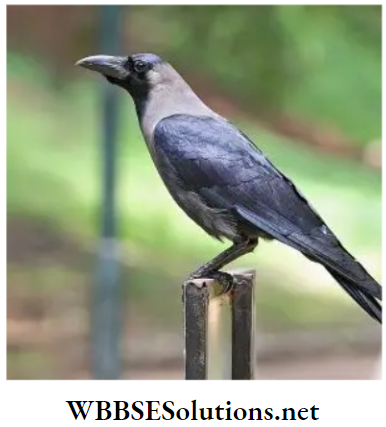
A raven has a deeper and less piercing sound. Their calls may sound like “Croooaaak”. Rooks are found across Europe and western Asia. They too, prefer wide open spaces, river plains and steppes.
Crows are extremely intelligent birds. They are known for their problem-solving skills and amazing communication skills.
For example, when a crow encounters a mean human, it will teach other crows how to identify the human. In fact, research shows that crows don’t forget a face.
Recent research has found some crow species capable of not only tool use but also tool construction.
Crows are now considered to be among the world’s most intelligent animals with intelligence equal to that of many non-human primates.
Many types of crows are solitary, but they will often forage in groups. Others stay in large groups.
Crows are omnivores, which means they eat nearly anything.
Crows eat small animals such as mammals, amphibians, reptiles, eggs and carrion. They also eat insects, seeds, grains, nuts, fruit, non-insect arthropods, molluscs, worms and even other birds.
Crows have also been noted eating garbage and storing food in caches, short-term, in trees or on the ground.
Crows are cooperative breeders, which means they often stay close to the place where they were born and help raise and defend the area’s young chicks.
When it is time to have offspring, a mating pair will build a nest 15 to 60 feet (4.5 to 18 metres) above the ground using branches.
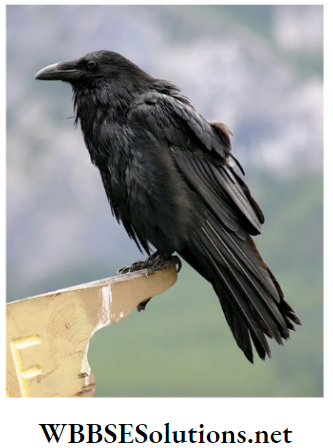
Chapter 11 Habits And Habitats Of Some Important Animals Mosquitoes
Mosquitoes are small insects. The word “mosquito” is derived from Spanish for “little fly”.
Thousands of species feed on the blood of various kinds of hosts, mainly vertebrates, including mammals, birds, reptiles, amphibians, and even some kinds of fish.
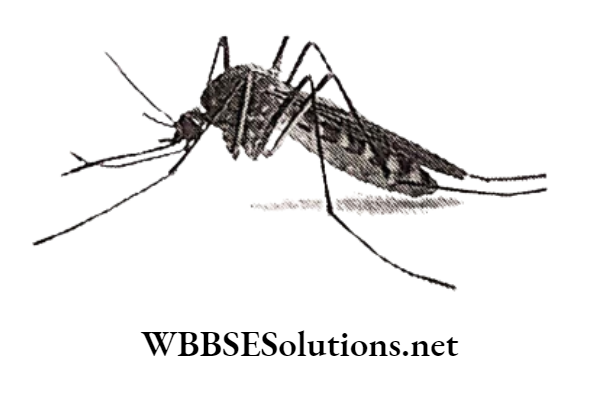
Both males and females feed mainly on fruit and plant nectar, but the female also needs the protein in her blood to help her eggs develop.
Once she’s had her fill of blood, she’ll rest for a couple of days before laying her eggs. The females “bite” with a long, pointed mouthpart called a proboscis.
They use the serrated proboscis to pierce the skin and locate a capillary, then draw blood through one of two tubes.
They also have a head, thorax and abdomen. On the head, there are two large compound eyes, two ocelli (simple eyes), two antennae and a proboscis.
Two large, scaled wings sprout from the thorax. twigs, hair, twine, bark, plant fibres, mosses, cloth and other materials.
Crows and ravens are important in mythology, fables and native cultures. They are often identified as clever tricksters.
In some cultures, they are symbols of good luck; in others, they bring bad luck. A group of crows is called a “murder”.
There are several different explanations for the origin of this term, mostly based on old folk tales and superstitions.
Many view the appearance of crows as an omen of death because ravens and crows are scavengers and are generally associated with dead bodies, battlefields, and cemeteries and they are thought to circle in large numbers above sites where animals or people are expected to die soon.
According to the International Union for Conservation of Nature (IUCN), most crows are not endangered.
Though the loss of blood is seldom of any importance to the victim, the saliva of the mosquito often causes an irritating rash that is a serious nuisance.
Much more serious though, are the roles of many species of mosquitoes as vectors of diseases.
In passing from host to host, some transmit extremely harmful infections such as malaria, yellow fever, Chikungunya, dengue fever, filariasis, Zika virus, etc. rendering it the deadliest animal family in the world.
Females can beat their wings up to 500 times per second, and the males pick out the higher frequency of those beats when seeking a mate.
Most mosquitoes can fly no more than about one to three miles and often stay within several hundred feet of where they were hatched.
They have receptors on their antennae that detect the carbon dioxide released when we exhale. Those plumes of CO, rise into the air, acting as trails that the mosquitoes follow to find the source.
Our skin produces several chemical odours, and some of them are like dinner to mosquitoes. There are more than 2,700 species of mosquitoes in the world. Of these genera, most mosquitoes belong to three
1. Aedes:
Aedes mosquitoes have abdomens with pointed tips. They include such species as the yellow-fever mosquito and the Asian tiger mosquito.
Adults of this mosquito have black bodies with conspicuous white stripes. They Coopersistently bite mammals (especially humans), mainly at dawn and in the early evening.
Their bites are painful. They b spread “Yellow fever”, Encephalitis, Si Dengue fever, etc.
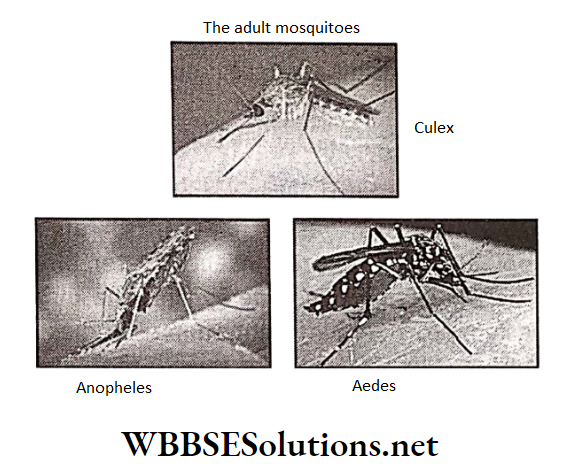
2. Anopheles:
These tend to breed in bodies of permanent fresh water. Anopheles mosquitoes also have abdomens with no pointed tips.
They include several species, such as the common malaria mosquito that can spread malaria to humans.
3. Culex:
These tend to breed in quiet, standing water. Culex mosquitoes have an abdomen with blunt tips. They are weak fliers and tend to live for only a few weeks during the summer months.
They persistently bite (preferring birds over humans) and attack at dawn or after dusk. Their bite is painful. Culex causes filariasis, bird malaria, encephalitis, and dengue.
Sound is produced due to the flapping of the wings of mosquitoes. Smaller mosquitoes produce more sound.
Like all insects, mosquitoes hatch from eggs and go through several stages in their life cycle before becoming adults.
The female lay their eggs in water, and the larva and pupa stages live entirely in water. When the pupa changes into adults, they leave the water and The adult mosquitoes become free-flying land insects.
Egg:
All mosquitoes lay eggs in water, which can include large bodies of water, standing water (like swimming pools) or areas of collected standing water (like tree holes or gutters).
Females lay their eggs on the surface of the water, except for Aedes mosquitoes, which lay their eggs above water in protected areas that eventually.
flood. The eggs can be laid singly or as a group that forms a floating raft of mosquito eggs.

Larva:
The mosquito eggs hatch into larvae or “wigglers”, which live at the surface of the water and breathe through an air tube or siphon.
As they grow, they shed their skin (moult) several times. Mosquito larvae can swim and dive down from the surface when disturbed.
Pupae:
After the fourth moult, mosquito larvae change into pupae, or “tumblers”, which live in the water anywhere from one to four days depending on the water temperature and species.
The pupae float at the surface and breathe through two small tubes (trumpets). At the end of the pupal stage, the pupae encase themselves and transform into adult mosquitoes.
Adult:
Inside the pupal case, the pupae transform into an adult.
The adult uses air pressure to break the pupal case open, crawls to a protected area and rests while its external skeleton hardens, spreading its wings out to dry. Once this is complete, it can fly away and live on the land.
Identifying larvae:
We can distinguish the larvae of various species of mosquito. Anopheles larvae lie parallel to the surface. of the water, while larvae of Aedes and Culex extend down into the water.
Mosquito Control Methods:
Insecticides can be used to help control mosquitoes. Some products are designed to be applied directly to water to control mosquito larvae, while others are used more broadly to control adult mosquitoes.
- There are steps you can take to reduce mosquito populations without using insecticides. Here are some tips to consider when trying to avoid mosquito bites:
- Empty water from containers such as flower pots, birdbaths, pet water dishes, cans, gutters, tires and buckets regularly to disrupt the mosquito breeding cycle.
- Keep windows and door screens in good working order to prevent mosquitoes from entering your home.
- If possible, wear long-sleeved shirts and long pants while outdoors, consider staying indoors early in the morning and evening when mosquitoes are most active. Consider using an insect repellent.
Chapter 11 Habits And Habitats Of Some Important Animals Fish
A fish is an animal which lives and breathes in water. All fishes are vertebrates (have a backbone) and most breathe through gills and have scales.
Fish make up about half of all known vertebrate species. Fish have been on the earth for more than 500 million years.

Fish were well established long before dinosaurs roamed the earth. There are three classes of fish: jawless, cartilaginous, and bony.
Fish are cold blooded, which means their internal body temperature changes as the surrounding temperature changes. 40% of all fish species inhabit fresh water.
Some fish like sharks don’t possess an air bladder to help keep them afloat and must either swim continually or rest on the bottom.
Some species of fish can fly (glide), others can skip along the surface and others can even climb rock.
Fish have a specialized sense organ called the lateral line which works much like radar and helps them navigate in dark or murky water.
Fish have excellent senses of sight, touch, and taste and many possess a good sense of smell and ‘hearing’. Fish feel pain and suffer stress just like mammals and birds.
Fish eat other fish, fish eggs, molluscs, aquatic plants, algae, zooplankton, terrestrial insects, water birds, turtles, frogs, etc.
In some species the males and females have different shaped bodies or different colouring; in other species, there is no visible difference. A person who studies fish is called an ichthyologist.
All fish have gills that allow them to breathe underwater. Just like we use our lungs to exchange oxygen for carbon dioxide from the air, the gills of a fish perform a similar function to water.
So fish still need oxygen to live, they just get it from the water instead of the air. Fish live in nearly every large body of water in the world including streams, rivers, ponds, lakes, and oceans.
Some fish live on the surface of the water and some live in the very depths of the ocean. There are fish that live in fresh water and others that live in salt water.
The reproduction of a species has to assure the survival of the species. Spawning occurs when the moment is the best for the survival of the fry, abundant food, shelter etc.
After spawning occurs, the eggs may be left or abandoned, or there may be some degree of parental care provided for by the male and/or female.
Parental care is not the rule in fish. Most species are quite content to abandon their offspring to the vagaries of a world populated by organisms that are fond of eating nutritious little snakes such as eggs and fry.
Though they may form a minority, parental species are nevertheless very diverse. They belong to many different families, marine as well as freshwater.
About 80% of these families are represented by species that care only for eggs.
These fishes prepare or build nests, sometimes nothing more than a cleaned rock, sometimes an amalgamation of vegetal matter, empty shells, pebbles, sand, or even air bubbles.
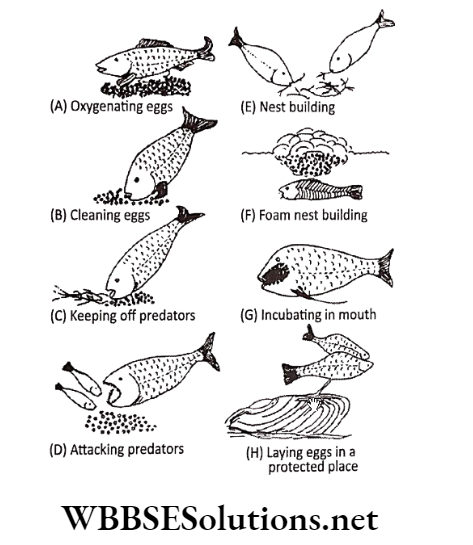
Parents also tirelessly fan the eggs-moving water over the brood with movements of their fins to provide them with a good supply of oxygen.
In addition, they clean the eggs by brushing them with their fins. With their mouth, they remove dead or diseased eggs. Some transfer mucus onto their eggs which has anti-microbial properties.
If the nest is in the intertidal zone, parents cover the egg batch with algae just before low tide, preventing desiccation.
Many species carry eggs with them so that if a big predator makes an entry onto the scene, the parents can flee and bring the brood with them.
The eggs are carried outside or inside the body.
Examples of outside carriers include medakas (eggs stuck to the female’s vent for a few hours), bagrid and banjo catfishes (eggs embedded on the surface of the belly) and sucker-mouth armoured catfishes (eggs attached to the male’s lower lip).
Inside- carriers include the numerous species of mouth-brooding cichlids (Cichlids are popular freshwater fish kept in the home aquarium), sea catfishes, and lumpfishes.
Cardinalfishes and gouramis (eggs carried inside the mouth, and regularly churned in there for proper cleaning and oxygenation), many seahorses and pipefishes (eggs developing inside a special ventral pouch on the male).
Seahorses are monogamous. The males incubate the eggs that are received from the female. Females do not play any parental care after mating.
Fertilization and incubation of oocytes received from females take place in a sac-like brood pouch located under the tail.

In most mouthbrooders (those species that carry eggs and fry within their mouth), only one parent provides care.
When all bony fishes are considered as a group, female-only care is the rarest form of parental involvement. The most common form is male-only care.
In such species, males aggressively stake out territories, prepare a spawning site, and court passing females.
Chapter 11 Habits And Habitats Of Some Important Animals Snakes
Snakes belong to the animal class of reptiles. This group also includes crocodiles, lizards, and turtles.
Reptiles are cold-blooded animals that raise their body temperature by lying in the sun or lowering it by crawling into the shade.
Their body temperature changes to the temperature of their surroundings. Because of this, snakes that live in colder climates must hibernate through the winter.
They will find burrows or caves and fall into a deep sleep until the weather becomes warm enough for them.
They constitute approximately 10 per cent of the total snake species found in the world and 80% of them are non-poisonous.
The venomous snakes include only about 58 species and there are only 4 species of snakes that are dangerous to man namely, Cobra, Krait, Russell’s viper and Saw-scaled viper.
Many species of snakes have skulls with several more joints enabling them to swallow prey much larger than their heads with their highly mobile jaws.
To accommodate their narrow bodies, snakes’ paired organs (such as kidneys) appear one in front of the other instead of side by side, and most have only one functional lung.
Living snakes are found on every continent except Antarctica, and on most smaller land masses exceptions include some large islands such as Ireland, Iceland, Greenland and the islands of New Zealand, and many small islands of the Atlantic and Central Pacific.
Additionally, sea snakes are widespread throughout the Indian Ocean and the Pacific Ocean.
All snakes are strictly carnivorous, eating small animals including lizards, frogs, other snakes, small mammals, birds, eggs, fish, snails or insects.
As snakes cannot bite or tear their food to pieces, they must swallow prey whole. Snakes do not ordinarily prey on humans.
Unless startled or injured, most snakes prefer to avoid contact and will not attack humans. Most species are non-venomous and those that have venom use it primarily to kill and subdue prey rather than for self-defence.
Some possess venom potent enough to cause painful injury or death to humans. Non-venomous snakes either swallow prey alive or kill by constriction.
Snakes use smell to track their prey. They smell by using their forked tongues to collect airborne particles, then passing them to Jacobson’s organ in the mouth for examination.
The fork in the tongue gives snakes a sort of directional sense of smell and taste simultaneously.
They keep their tongue constantly in motion, sampling particles from the air, ground, and water, analyzing the chemicals found and determining the presence of prey or predators in the local environment.
Snake vision varies greatly, from only being able to distinguish light from dark to keen eyesight, but the main trend is that their vision is adequate although not sharp, and allows them to track movements.

The part of the body in direct contact with the ground is very sensitive to vibration; thus a snake can sense other animals approaching by detecting faint vibrations in the air and on the ground.
The skin of a snake is covered in scales. Most snakes use specialized belly scales to travel, gripping surfaces.
The shedding of scales is called ecdysis (or in normal usage, moulting or sloughing). In the case of snakes, the complete outer layer of skin is shed in one layer.
Moulting occurs periodically throughout the snake’s life. Most snakes lay eggs. But snakes like Chandrabora and Metuli directly give birth to young ones.
Cobras, vipers and closely related species use venom to immobilize or kill their prey. The venom is modified saliva, delivered through fangs.
The term “poisonous snake” is mostly incorrect. Poison is inhaled or ingested, whereas venom is injected. Some poisons affect the nervous system while some affect the blood circulatory system.
Snake venoms are complex mixtures of proteins, and are stored in venom glands at the back of the head.
All snakes may be venomous to a certain degree, with harmless snakes having weak venom and no fangs. The treatment for snake bite is as variable as the bite itself.
The most common and effective method is through antivenom, a serum made from the venom of the snake.
In some parts of the world, especially in India, snake charming is a roadside show performed by a charmer.
In such a show, the snake charmer carries a basket that contains a snake that he seemingly charms by playing tunes from his flute-like musical instrument, to which the snake responds.
Snakes lack external ears, though they do have internal ears, and respond to the movement of the flute, not the actual noise.
The Wildlife Protection Act of 1972 in India technically proscribes snake charming on the grounds of reducing animal cruelty.
No matter how you feel about snakes, they play an important role.
All snakes are carnivores and most of them eat rodents, such as mice, rabbits and rats. Rodents eat human food and crops. They also carry diseases.
Snakes keep rodent populations under control. Without their help, rodents would over-run the earth.

Chapter 11 Habits And Habitats Of Some Important Animals Tiger
The Tiger (Panthera tigris) is the largest cat species, most recognisable for their pattern of dark vertical stripes on reddish-orange fur with a lighter underside.
Tigers have muscular bodies with powerful forelimbs, large heads and long tails.
The fur is dense and heavy; colouration varies between shades of orange and brown with white ventral areas and distinctive vertical black stripes, whose patterns are unique to each individual.
Their function is likely for camouflage in vegetation such as long grass with strong vertical patterns of light and shade.
They have a mane-like heavy growth of fur around the neck and jaws and long whiskers, especially in males. The pupils are circular with yellow irises.
The small, rounded ears have a prominent white spot on the back, surrounded by black.
A Tiger’s canine teeth can grow up to three inches long and are easily capable of crunching through the spine of any creature on Earth.
White tigers, this recessive colour variant is found only in the Bengal subspecies and with regular stripes and blue eyes. It is not albinism.
They appear on many flags, and coats of arms, and as mascots for sporting teams. The tiger is the national animal of India, Bangladesh, Vietnam, Malaysia and South Korea.
Adult tigers lead largely solitary lives. They establish and maintain territories but have much wider home ranges within which they roam.
Resident adults of either sex generally confine their movements to their home ranges, within which they satisfy their needs and those of their growing cubs.
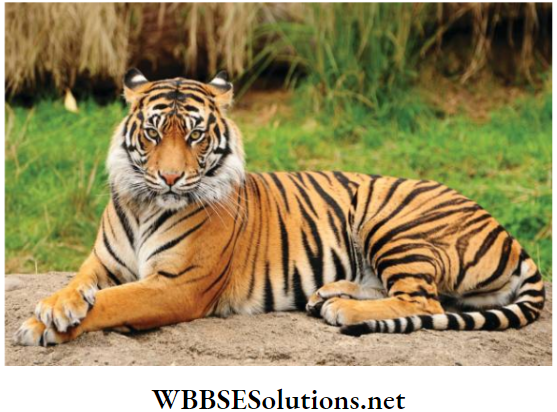

Individuals sharing the same area are aware of each other’s movements and activities. The size of the home range mainly depends on prey abundance, and in the case of males, on access to females.
Tigers are strong swimmers and often deliberately bathe in ponds, lakes and rivers as a means of keeping cool in the heat of the day. They are able to carry prey through or capture it in the water.
To identify his territory, the male marks trees by spraying urine and anal gland secretions, as well as marking trails with faeces and marking to typically absent, they have been observed via remote-controlled hidden cameras.
They generally hunt alone and ambush their prey as most other cats do, overpowering them from any angle, using their body size and strength to knock the prey off balance.
After killing their prey, tigers sometimes drag it to conceal it in vegetative cover, usually pulling it by grasping with their mouths at the site of the killing bite.
This too, can require great physical strength. zieminA transom trees or the ground with their claws. Females also use these “scrapes”, as well as urine and scat markings.
Scent markings of this type allow an individual to pick up information on another’s identity, sex and reproductive status.
Roar is produced in a variety of situations such as taking down large prey, signalling sexual receptivity and females calling to their young. These roars may be heard from distances over 3 km.
Male tigers are generally more important to other males within their territories than females are of other females.
Territory disputes are usually solved by displays of intimidation rather than outright aggression.
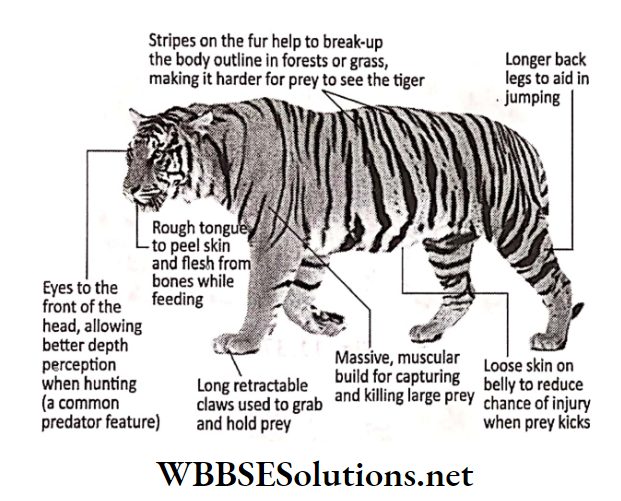
In the wild, tigers mostly feed on large and medium-sized animals, preferring native ungulates weighing at least 90 kg. They typically have little or no deleterious effect on their prey populations.
Sambar deer, chital, barasingha, wild boar, gaur, nilgai and both water buffalo and domestic buffalo, etc. are the tiger’s favoured prey in India.
They also prey on other predators, including dogs, leopards, pythons, sloth bears and crocodiles.
Tigers generally do not prey on fully grown adult Asian elephants and Indian rhinoceros but incidents have been reported.
Old or wounded tigers, unable to catch wild prey, can become man-eaters; this pattern has recurred frequently across India.
An exception is in the Sundarbans, where healthy tigers prey upon fishermen and villagers in search of forest produce, humans thereby forming a minor part of the tiger’s diet.
Tigers are thought to be mainly nocturnal predators, but in areas where humans are Tigers make extensive use of their vision for everyday functions and applications (in much the same way as human beings), particularly for hunting during the darkness of night or the limited visibility of dusk or storms.
Tigers hunt mainly during the evening and night times when the vision of their prey is compromised. For this reason, their nighttime vision is excellent; about six times better than that of humans.
There are several adaptations within the actual eye that allow for this. It has a wide, rounded pupil that allows maximum light to enter into the eye, when necessary.
The tiger’s retinas comprise mainly rod receptors, which are cells that are sensitive to low light levels and can perceive very slight movements.
There are some cone cells (colour receptors) in each eye, but these are used more for day vision, and not to perceive a range of different colours.
In fact, it is thought that some tigers only see dull greens, blues and reds, while others see in black and white.
The tapetum lucidum is a layered, mirror-like structure behind the retina that reflects light back into the eyes for a second time so that the eye and brain can form a brighter image of it.
The eyes of the tiger are situated on the front of its head, and not on the sides. This helps with three-dimensional perception and depth perception since both eyes look ahead.
Mating can occur all year round but is more common between November and April. A female is only receptive for three to six days. Mating is frequent and noisy during that time.
The litter is usually two or three cubs, occasionally as few as one or as many as six. Cubs are born blind and helpless.
The females rear them alone, with the birth site and maternal den in a sheltered location such as a thicket, cave or rocky crevice. The male generally takes no part in rearing them.

First tigress hunts and gives pieces of meat to the cubs. The tigers teach them to eat the meat by showing them how to tear it with their teeth.
She also teaches them to swim. After training from the mother for six or seven months, the tigers finally become adults.
The tiger is an endangered species. Poaching for fur and body parts and the destruction of habitat have simultaneously greatly reduced tiger populations in the wild.
At the start of the 20th century, it is estimated there were over 100,000 tigers in the wild, but the population has dwindled outside of captivity to between 1,500 and 3,500.
India is home to the world’s largest population of wild tigers. In 1973, India’s Project Tiger established over 25 tiger reserves in reclaimed land, where human development was forbidden.
Tigers occupy a variety of habitats from tropical forests, evergreen forests, woodlands and mangrove swamps to grasslands, savannah and rocky country.
Tigers do not actually live in Africa; they live in Asia. Tigers are seated at the top of the food chain predators maintaining the ecological balance of populations by keeping prey populations in check.
When a tiger has eaten its prey, the abandoned prey becomes the food for a variety of mammals, birds and reptiles.
Some cultures believe that powdered tiger bones have medicinal value. Unfortunately, tigers are highly in demand to supply this damaging market.
Chapter 11 Habits And Habitats Of Some Important Animals Whale
Whales are the common name for a widely distributed and diverse group of fully aquatic placental marine mammals.
Whales, dolphins and porpoises are the closest living relatives of the hippopotamuses, having diverged about 40 million years ago.
Whales are creatures of the open ocean; they feed, mate, give birth, suckle and raise their young at sea.
So extreme is their adaptation to life underwater that they are unable to survive on land.
Whales range in size from 2.6 metres (8.5 ft) and 135 kilograms dwarf sperm whales to 34 metres (112 ft) and 190 metric tons blue whales, which is the largest creature that has ever lived.
The sperm whale is the largest-toothed predator on Earth.
Whales have torpedo-shaped bodies with non-flexible necks, limbs modified into flippers, non-existent external ear flaps, a large tail fin, and flat heads.
Whale skulls have small eye orbits, long snouts and eyes placed on the sides of its head.
Several species exhibit sexual dimorphism, in that the females are larger than males. One exception is the sperm whale, which has males larger than the females.

Baleen whales have no teeth; instead, they have plates of baleen, a fringe-like structure used to expel water while retaining the krill and plankton which they feed on.
Baleen whales have heads that can make up 40% of their body mass to take in water. Toothed whales, on the other hand, have conical teeth designed for catching fish or squid.
Baleen whales have a well-developed sense of “smell”, whereas toothed whales have well-developed hearing- their hearing, which is adapted for both air and water is so well developed that some can survive even if they are blind.
Some species, such as sperm whales, are well adapted for diving to great depths to catch squid and other favoured prey. All whales are carnivorous and predatory.
Usually, whales hunt solitarily, but they do sometimes hunt co-operatively in small groups. Whales have evolved from land-living mammals.
As such they must breathe air regularly, though they can remain submerged for long periods.
They have blowholes (modified nostrils) located on top of their heads, through which air is taken in and expelled in the form of vapour.

Breathing involves expelling stale air from the blowhole, forming an upward, steamy spout, followed by inhaling fresh air into the lungs; a humpback whale’s lungs can hold about 5,000 litres of air.
Whales are mammals, and as such, they have hair- though very little of it. They feed milk to their babies and breathe air.
Since whales are not fish they do not have gills, so they cannot breathe underwater. Whales have two flippers on the front and a tail fin. These flippers contain four digits.
The fusing of the neck vertebrae, while increasing stability when swimming at high speeds, decreases flexibility; whales are unable to turn their heads.
When swimming, whales rely on their tail fin that propels them through the water. Flipper movement is continuous.
Whales swim by moving their tail fin and lower body up and down, propelling themselves through vertical movement, while their flippers are mainly used for steering.
Whales are adapted for diving to great. depths. In addition to their streamlined bodies, they can slow their heart rate to conserve oxygen.
They are warm-blooded, and have a layer of fat, or blubber, under the skin. This allows them to maintain a body temperature similar to humans – 36°C (97°F), even in freezing conditions.
In species that live near the poles, the blubber can be as thick as 11 inches.
This blubber can help with buoyancy, and protection to some extent as predators would have a hard time getting through a thick layer of fat, and energy for fasting when migrating to the equator; the primary usage for blubber is insulation from the harsh climate.
With streamlined fusiform bodies and two limbs that are modified into flippers, whales can travel at a speed up to 37 km in an hour.
Whales produce a great variety of vocalizations, notably the extended songs of the humpback whale. Whale vocalization is likely to serve several purposes.
Some species, such as the humpback whale, communicate using melodic sounds, known as whale songs. These sounds may be extremely loud, depending on the species.
Captive whales have occasionally been known to mimic human speech. Whales are not thought to have a good sense of taste and smell. Whales are known to teach, learn, cooperate, scheme, and grieve.
Although whales are widespread, most species prefer the colder waters of the Northern and Southern hemispheres and migrate to the equator to give birth.
Species such as humpbacks and blue whales are capable of travelling thousands of miles without feeding.
Calves are typically born in the spring and summer months and females bear all the responsibility for raising them. Mothers of some species fast and nurse their young for a relatively long period of time.
The whale eye is relatively small for its size, yet they do retain a good degree of eyesight.
As well as this, the eyes of a whale are placed on the sides of its head, so its vision consists of two fields, rather than a binocular view like humans have.
Most whales have slightly flattened eyeballs, enlarged pupils, slightly flattened corneas and a tapetum lucidum these adaptations allow for large amounts of light to pass through the eye and therefore, a very clear image of the surrounding area.
In water, a whale can see around 10.7 metres (35 ft) ahead of itself.
Scientists have determined that killer whales can live a maximum of 35 years. They can tell the age of a whale by looking at a cross-section of a killer whale’s tooth.
Unlike most animals, whales are conscious breathers. All mammals sleep, but whales cannot afford to become unconscious for long because they may drown.
Another interesting feature of whales is that whales are known to give birth to their children much like humans do.
The female whale goes through a pregnancy period that can last anywhere from 10 months all the way up to 17 months depending on the species.
Once relentlessly hunted for their products, whales are now protected by international law.

